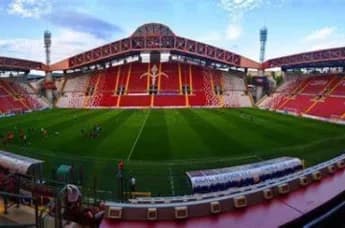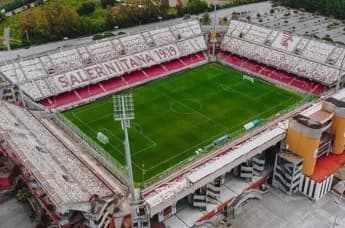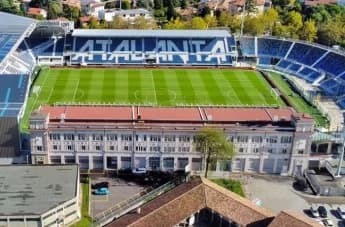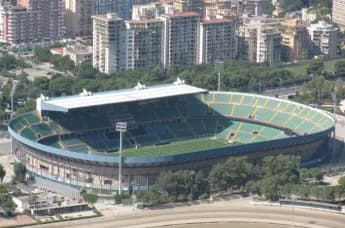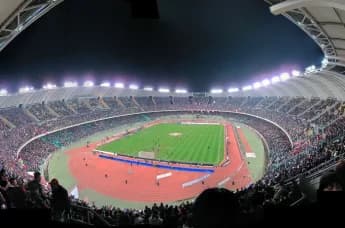The Olympiastadion Munich is a stunning sports landmark with a rich history, hosting both memorable events and concerts that shape its enduring legacy in global culture.
The Olympiastadion Munich, situated in the center of Germany's lively capital of Bavaria, serves as a remarkable symbol of athletic excellence and architectural triumph. Built originally for the 1972 Summer Olympics, the stadium has evolved into a celebrated landmark, hosting numerous important sporting events, concerts, and cultural activities. Its distinctive design, combined with its rich history, makes it one of the most iconic sports venues globally.
Construction of the stadium commenced in 1968, designed by the esteemed architect Günter Behnisch. It was finished in time for the 1972 Olympics, showcasing an innovative and futuristic design that became one of the highlights of the Games. The stadium's most notable feature is its expansive, undulating transparent roof, held up by an intricate network of cables. This roof design was revolutionary for its time and continues to be a striking element of the venue today.
The Olympiastadion has a seating capacity of up to 69,000 for football matches, making it one of the largest stadiums in Germany. This capacity, along with the stadium’s modern facilities and outstanding acoustics, creates an exhilarating atmosphere during significant events. The Olympiastadion serves as the home ground for Bayern Munich, one of Europe's most successful football clubs, and also hosts major international matches and tournaments. Its reputation as a premier football venue is solidified by its role in the 1974 FIFA World Cup Final, where West Germany triumphed over the Netherlands, earning their second World Cup title.
Throughout the years, the stadium has played host to some of the most unforgettable moments in football, making it a pilgrimage destination for fans from all over the world. Bayern Munich's matches at the Olympiastadion have been legendary, with the supporters known for their steadfast loyalty and for creating an unparalleled atmosphere. Additionally, the stadium served as the home ground for TSV 1860 Munich for many years, reinforcing its reputation as a vital center for the city's football culture.
Although football is the main sport played at the stadium, the Olympiastadion has been the venue for a range of other sporting activities, such as athletics, rugby, and American football. Additionally, it has hosted concerts featuring some of the largest musical stars in the world, highlighting its adaptability. Iconic performers like Michael Jackson, U2, and the Rolling Stones have graced the stadium, attracting thousands of fans to experience memorable shows.
Located within the Olympic Park, the Olympiastadion is encircled by a vast green area that features the Olympic Tower, a swimming complex, and various other sports venues. The park is a favored spot for both visitors and residents, providing numerous recreational opportunities and breathtaking views of the city along with the distant Bavarian Alps.
The history of the Olympiastadion is closely linked to the heritage of Munich. It has been a witness to significant events in both German and global history, becoming a vital aspect of the city's cultural and athletic identity. Over the years, the stadium has seen numerous renovations to maintain its status as a modern sports facility. These enhancements have included upgrades to seating, lighting, and the installation of a new playing surface, ensuring it meets the highest standards for both players and fans.
In 2005, the Allianz Arena became the official home of Bayern Munich, replacing the stadium. Nevertheless, the Olympiastadion retains its significance in the city's sports calendar. It continues to host major international events, including UEFA Champions League finals, international friendly matches, and large concerts. Its reputation as one of Europe's most renowned sports venues continues to draw sports enthusiasts, tourists, and event attendees from across the globe.
The Olympiastadion in Munich is a remarkable symbol of the city’s deep-rooted sporting culture and innovative architecture. Its impact is felt well beyond the realm of football, establishing itself as an iconic cultural site in the sporting and entertainment landscape. Whether for an exciting game, a memorable concert, or as a part of Munich’s Olympic heritage, the Olympiastadion stands as a beacon of excellence, history, and fervor.
Background and Building Process
The Olympiastadion Munich, representing innovation and sportsmanship, boasts a rich and captivating history. Its construction and ongoing use have established it as one of the most iconic sports venues globally. Built for the 1972 Summer Olympics, a pivotal event for both Germany and the international sporting community, the story of its creation and the subsequent events forms a crucial part of the Olympiastadion's legacy.
The decision to construct the Olympiastadion was made after Munich was chosen to host the 1972 Summer Olympics. The city aimed to demonstrate its recovery after the war, and the stadium was intended to be the focal point of the Games. Building the stadium was part of a larger initiative to develop the entire Olympic Park, a vast area designed to not only facilitate the Games but also to leave a lasting legacy for the city. The design of the stadium was assigned to German architect Günter Behnisch, whose goal was to create a structure that was both functional and visually appealing.
Behnisch's design for the Olympiastadion was groundbreaking. The stadium is distinguished by its expansive, wavy roof made from translucent acrylic glass and held up by steel cables. This innovative design created a spacious and airy atmosphere while shielding spectators from the weather. The roof's distinctive structure was among the first of its kind, paving the way for future stadium architectures around the globe. Additionally, the design featured large, sweeping curves that imparted a fluid, organic appearance to the stadium, embodying the energy and vibrancy of the Olympic Games.
The construction of the Olympiastadion commenced in 1968, with a team led by the German construction company Philipp Holzmann AG serving as the primary contractors. This large-scale project necessitated the collaboration of thousands of workers. The stadium was erected on land that was previously used as a military training facility, which required extensive excavation and preparation. One of the major challenges the construction team encountered was ensuring the site complied with Olympic standards while also being versatile enough for future use as a multipurpose venue.
The construction of the stadium was finished just in time for the 1972 Summer Olympics, with its official opening occurring on August 26, 1972. The opening ceremony of the Olympics was held at the Olympiastadion, kicking off a series of events scheduled over the following two weeks. The stadium's inaugural event was a tremendous success, captivating both athletes and spectators with its contemporary design and advanced facilities.
The 1972 Olympics represented a significant event for both Germany and the global sports community. The Olympiastadion was the site of numerous key events, such as the opening and closing ceremonies, athletics competitions, and football matches. A particularly notable moment in the stadium's legacy took place during the Olympic football tournament, where the West German national team won the gold medal in front of their home fans. This triumph brought immense pride to the German people and further established the Olympiastadion as a vital landmark in the nation’s sporting heritage.
Following the Olympics, the Olympiastadion remained a venue for various events. It became the home ground for FC Bayern Munich, one of Europe's most successful football teams, and TSV 1860 Munich, solidifying its reputation as a football stronghold. Throughout the years, the stadium has hosted many national and international football matches, including qualifiers for the World Cup and European Championship, as well as significant club tournaments such as the UEFA Champions League.
In the years following its establishment, the Olympiastadion underwent numerous renovations to ensure it remained a premier sporting venue. These enhancements included upgrades to seating, lighting, and the playing surface, as well as the incorporation of contemporary facilities for athletes and fans. The stadium's innovative design from 1972 has continued to shape the architecture of modern sports complexes across the globe.
In 2005, Bayern Munich moved to the Allianz Arena, leaving the Olympiastadion. Nevertheless, the stadium remains a venue for major sporting events, concerts, and cultural activities. Its legacy as an architectural wonder and a significant part of Germany's sports history endures, making it one of the most esteemed venues worldwide.
The story of the Olympiastadion Munich encompasses innovation, perseverance, and a lasting legacy. Established in the late 1960s and serving as a key venue for the 1972 Olympics and beyond, the stadium has been central to the development of German sports as well as the broader global sporting culture. Its pioneering design and profound cultural significance render it an enduring emblem of sporting success.
Architectural and Design Characteristics
The Olympiastadion in Munich is widely recognized as an architectural masterpiece, not just for its innovative design but also for its harmonious blend of aesthetics and functionality. Created by German architect Günter Behnisch and constructed for the 1972 Summer Olympics, the stadium stands as one of the most iconic sports venues globally. Its architectural and design attributes reflect the vision of its creators and have inspired countless architects and engineers over the years. The stadium’s design is lauded for its daring, futuristic elements, many of which were revolutionary when it was built.
A notable feature of the Olympiastadion is its unique roof design. This roof, which spans most of the seating area, consists of a translucent, flowing canopy supported by an intricate arrangement of steel cables. At the time of its construction, the roof's design was groundbreaking, representing one of the early large-scale applications of tensile architecture, which utilizes tension instead of compression to support structures. The roof’s elegant curves serve not only as an aesthetic element but also aim to convey a sense of movement, energy, and fluidity, mirroring the vibrant essence of the Olympic Games. Constructed from a lightweight acrylic glass material, the roof enables natural daylight to illuminate the seating area during the day while shielding it from adverse weather conditions. This pioneering approach to materials and design established a new standard in stadium architecture.
The overall shape of the Olympiastadion is a crucial aspect of its design. It features an oval layout, with the seating area gently arching around the central playing field. This configuration fosters a close-knit atmosphere for spectators, providing excellent sightlines and a strong connection to the action on the field. The stadium's smooth curves are enhanced by the organic shape of the roof, which blends effortlessly with the surrounding landscape. The arrangement of the seating sections is also significant, as the upper and lower tiers are meticulously designed to optimize visibility and ensure a comfortable experience for all attendees.
An additional remarkable feature of the Olympiastadion’s design is its seamless integration with the surrounding environment. Situated within the Olympic Park, a sprawling green area that was also created for the 1972 Olympics, the stadium is part of a larger complex that includes facilities like the Olympic Tower, the swimming hall, and various sports complexes. The design of the stadium leverages its natural surroundings, with a transparent roof that offers views of the nearby hills and the city skyline. The open spaces around the stadium further strengthen the connection between the venue and the landscape, making the Olympiastadion a cohesive element of Munich’s urban setting.
From the perspective of structural engineering, the Olympiastadion exemplifies the innovative use of contemporary materials and building methods. The cable-supported roof is not only visually impressive but also highly functional. Utilizing cables for roof support enables wide, unobstructed seating areas beneath, creating an expansive and airy atmosphere within the stadium. Tall masts that support the steel cables enhance the architectural drama of the facility. Moreover, the application of tensile architecture allows for a more efficient construction process and a decrease in material usage compared to conventional rigid roof designs, thus lowering the overall weight of the stadium.
The seating layout in the Olympiastadion was thoughtfully designed to enhance the experience for spectators. Both the upper and lower tiers of seats are crafted to offer optimal sightlines, ensuring a clear view of the field for fans in every section of the stadium. The seating bowl features a gentle upward slope, which not only improves visibility but also fosters a feeling of closeness to the action on the field. The seats are arranged in concentric rings, with each tier offering a unique perspective of the venue.
Beyond its impressive roof and seating configurations, the Olympiastadion encompasses various architectural features that contribute to its distinctive design. The stadium's exteriors are constructed using a blend of concrete, glass, and steel, highlighting spacious areas that facilitate natural ventilation and illumination. The incorporation of glass within the stadium’s walls fosters a feeling of openness, merging the boundaries between the venue's interior and exterior.
Throughout the years, the Olympiastadion has seen numerous renovations to ensure it remains a contemporary sports venue. These enhancements have focused on upgrades to seating, lighting, and the playing field, along with the introduction of modern facilities for both players and fans. Nevertheless, the essential architectural elements of the stadium have been preserved, maintaining its reputation as one of the foremost examples of stadium design worldwide.
The architectural and design aspects of the Olympiastadion in Munich highlight the creativity and vision of its designers. Its groundbreaking roof design, the harmonious integration with the surrounding environment, and the focus on enhancing the spectator experience have contributed to making the Olympiastadion one of the most renowned sports venues globally. This innovative architecture continues to motivate and influence architects and designers, serving as a lasting emblem of Munich’s dedication to excellence in both sports and architecture.
Venue Ambiance and Audience Engagement
The Olympiastadion in Munich, known for its rich history and stunning architecture, provides a uniquely exciting atmosphere and an exceptional fan experience, making it one of the most iconic sports venues globally. With its lively and thrilling football matches and a wide variety of events, the stadium creates an unmatched setting for fans to fully engage in the excitement of live sports, music, and culture. The ability of Olympiastadion to foster a memorable and exhilarating environment is deeply embedded in its design, its enthusiastic fan following, and the vibrant energy that permeates the venue during significant events.
The atmosphere at the Olympiastadion during football matches is one of the most defining aspects of the fan experience. Home to two of Munich’s largest football clubs, Bayern Munich and TSV 1860 Munich, the stadium often fills with enthusiastic supporters, creating an electrifying environment. The fan experience is further amplified by the stadium's acoustics, which enhance the sounds of cheering fans, spirited chants, and the resounding roars of the crowd. Whether it’s an intense Bundesliga clash or a vital UEFA Champions League match, the Olympiastadion vibrates with the voices of thousands of fans, contributing an undeniable intensity to the game.
The design of the Olympiastadion plays a crucial role in shaping the atmosphere. The seating arrangement places fans in close proximity to the action, fostering a sense of intimacy and engagement. With nearly 70,000 seats available, the stadium provides outstanding visibility from all areas, and the steep, curved tiers help to maintain sound and excitement, ensuring that spectators in the upper sections remain connected to the game. The venue's open design, along with the translucent roof, allows natural light to illuminate the field, enhancing the dramatic ambiance during daytime matches, while the floodlighting system generates an exhilarating atmosphere during evening games.
The experience of fans at the Olympiastadion goes beyond the design of the stadium and is significantly shaped by the football culture in Munich. Bayern Munich’s fan base, known as the 'FCB Ultras,' is famed for their relentless support, infusing each match with immense passion and energy. The sections occupied by supporters are often adorned with banners, flags, and the smoke of flares, creating a vibrant and visually stimulating atmosphere that further invigorates the attendees. The chants and songs from the fans resonate throughout the stadium, especially during critical moments of the game when the crowd's excitement peaks. The dedication of the fans is palpable, making it common for the Olympiastadion to feel like an unassailable fortress when the home team is on the offensive. This generates an exhilarating and often daunting environment for opposing teams.
The Olympiastadion provides an outstanding fan experience that extends beyond just football. The venue accommodates a diverse array of events, including major concerts, athletics competitions, and international rugby matches. Each of these events brings a unique energy that enhances the stadium’s reputation as a versatile and dynamic location. For instance, during concerts, the stadium's open design optimizes acoustics, offering a more immersive experience for attendees. Fans have had the opportunity to witness performances from some of the world's most renowned musicians, with legends like U2, the Rolling Stones, and Michael Jackson having performed at the Olympiastadion. The enthusiasm and anticipation for these events are tangible, as thousands of fans flock together to experience the performances in a setting that is integral to the overall ambiance as the music itself.
The venue's placement within the vast Olympic Park significantly enhances the overall experience for fans. The park's lush landscapes, lakes, and pathways offer plenty of opportunities for fans to unwind and mingle before or after an event. Many attendees opt to gather in the designated areas of the park, enjoying picnics or beverages, which fosters a festive atmosphere and strengthens the sense of community. Furthermore, the closeness of the Olympic Tower and other amenities within the park allows fans to relish breathtaking panoramic views of Munich, providing a scenic backdrop that enriches the event experience.
Accessibility is a vital aspect that greatly enhances the fan experience at the Olympiastadion. The stadium is well-connected by Munich's efficient public transportation system, allowing fans to easily travel to and from the venue. The S-Bahn, U-Bahn, and tram lines provide straightforward access from various locations within the city, ensuring that fans can reach the stadium without difficulty. Inside, the venue features a variety of amenities, including modern seating, high-quality food and beverage options, and different fan zones designed to cater to diverse tastes and preferences.
For families attending, the Olympiastadion provides a welcoming atmosphere with designated areas for families to enjoy the event together. The fan experience is made to be inclusive, featuring accessible seating for individuals with disabilities and a variety of facilities ensuring that everyone, regardless of age or physical ability, can fully participate in the event.
The Olympiastadion is unmatched in its ability to create an atmosphere for major international events. Its historical significance, breathtaking architecture, and fervent fan support come together to forge an exhilarating and immersive experience. Whether it’s the cheering of the fans during a Bayern Munich game, the thrill of an athletics competition, or the excitement of a top-tier concert, the Olympiastadion is a place where emotions soar and lasting memories are created.
The atmosphere and fan experience at the Olympiastadion in Munich are essential to the venue's reputation as a premier destination for sports and entertainment. The blend of enthusiastic supporters, outstanding acoustics, cutting-edge design, and a varied calendar of events all contribute to the vibrant energy that permeates the stadium. With its iconic football games, unforgettable concerts, and cultural gatherings, the Olympiastadion provides an unparalleled experience, making it a must-visit location for sports and entertainment fans worldwide.
The History and Heritage of the Olympiastadion in Munich
The Olympiastadion Munich is renowned as one of the most iconic sports venues globally, celebrated not only for its architectural excellence and historical importance but also for the remarkable achievements and lasting legacy that have emerged since its inauguration in 1972. Throughout the years, the stadium has been the site of many unforgettable events that have shaped the history of sports and entertainment. From Olympic victories to moments of football glory and significant cultural events, the records and legacy of the Olympiastadion are intricately linked to the cultural identity of Munich and the wider sporting community.
Significant Events and Achievements
The history of the Olympiastadion began with its construction for the 1972 Summer Olympics, quickly becoming a symbol of Germany's post-war revival and modernity. A key moment in the stadium's timeline happened during the 1972 Olympic Games, when it hosted the opening and closing ceremonies along with many athletics events. The stadium also held its first Olympic football final, where the West German national team secured the gold medal by defeating Poland 3-1. This triumph laid the groundwork for the stadium's enduring association with football, establishing its significant role in international sports.
The 1974 FIFA World Cup marked another significant milestone for the Olympiastadion. It hosted the final match in which West Germany triumphed over the Netherlands 2-1, securing their second World Cup title. This match is memorable not only for its thrilling moments but also for the profound historical importance of West Germany's win on their home turf. The Olympiastadion became the backdrop for one of football's most legendary matches, solidifying its status in World Cup history.
Beyond hosting Olympic and World Cup events, the stadium has set several records in football. As the home ground of Bayern Munich, one of the most successful football clubs globally, the Olympiastadion has been the site of numerous league titles, domestic cup wins, and European successes. Bayern Munich's supremacy in the Bundesliga was prominently showcased at the Olympiastadion, where the team claimed multiple German championships and DFB-Pokal titles. The stadium also played host to some of Bayern Munich's most unforgettable matches in the UEFA Champions League, including their exhilarating win in 2001 when they secured the European Cup following a dramatic penalty shootout victory over Valencia.
Besides football, the Olympiastadion has established itself as a significant venue for athletics. It served as the site for the track and field events during the 1972 Summer Olympics, and its outstanding design provided an excellent backdrop for elite athletic performances. Throughout the years, the stadium has been the host for various international athletics competitions, such as the 1986 European Athletics Championships and the 2002 IAAF World Cup. The Olympiastadion has witnessed numerous national records, particularly in events like the 100 meters and pole vault, highlighting the top-tier athletic performances that the venue supports.
Cultural Milestones and Concerts
In addition to hosting sporting events, the Olympiastadion has emerged as a prominent venue for concerts, further cementing its status as a cultural center. The stadium has seen performances by some of the most renowned musical artists worldwide, including U2, Michael Jackson, the Rolling Stones, and Pink Floyd. These concerts have drawn hundreds of thousands of fans from across the globe, with the Olympiastadion’s excellent acoustics and impressive architecture offering an ideal setting for these iconic shows.
A highlight in the stadium's cultural history was the 1990 concert by the German rock band Scorpions, which was featured in their "World Wide Live" album and video. The massive scale of these performances has enhanced the Olympiastadion’s global reputation, turning it into a versatile venue that serves not only as a sports arena but also as a hub for entertainment on an international level.
Legacy
The legacy of the Olympiastadion extends beyond its records; it also embodies significant cultural and architectural value. It has emerged as a defining symbol of Munich's identity and its role in the larger narrative of international sports history. The stadium's state-of-the-art design, characterized by a transparent, cable-supported roof, represented a revolutionary achievement during its construction. It has set a precedent for future sports venues globally, with numerous stadiums drawing inspiration from the Olympiastadion's innovative material usage and design. The unique roof of the stadium is still celebrated as one of the most aesthetically pleasing and technically advanced structures in the realm of sports architecture.
In addition, the legacy of the Olympiastadion goes beyond its athletic accomplishments. It served as a major venue during the 1972 Munich Olympics, which, despite the tragic events of the Munich massacre, is regarded as a pivotal moment in Olympic history. The stadium is a symbol of the resilience and strength of the German people, representing the nation's recovery and progress following the destruction of World War II.
The Olympiastadion is a significant aspect of Munich's history and its sports culture. Situated within the Olympic Park, which is recognized for its lush greenery and modern architecture, the stadium and the park have been the venue for a wide array of events, ranging from community celebrations to international sporting events, attracting millions of visitors annually.
For many years, the Olympiastadion has been home to Bayern Munich, cherished by fans who link the venue to the club's achievements. The stadium has been a witness to Bayern Munich's journey to international fame, marked by numerous Bundesliga titles, DFB-Pokal victories, and European championships. Although the team currently plays at the Allianz Arena, the Olympiastadion continues to represent Bayern Munich's illustrious past and the devoted supporters who have stood by the team through all challenges.
The legacy of the Olympiastadion is also reflected in its function as a host for numerous significant international events. The stadium has welcomed several UEFA Champions League finals and continues to be one of the top venues for European football. Additionally, it remains active for international friendly matches, concerts, and even rugby games, ensuring that its legacy stays pertinent in today’s sports and entertainment arena.
The legacy and records of Munich's Olympiastadion are characterized by its historical importance, architectural creativity, and lasting influence on sports and culture. The venue has made significant contributions by hosting the 1972 Summer Olympics and the 1974 FIFA World Cup final, in addition to being the stage for Bayern Munich's most significant victories, firmly establishing itself as one of the legendary sports arenas. Additionally, as a cultural space hosting performances by renowned artists, the stadium further cements its status as a diverse landmark. By continuing to serve as a venue for major events and embodying Munich's identity, the Olympiastadion's legacy will be cherished for generations.



